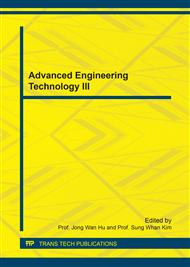[1]
V. Venkatesh, J. Thong, X. Xu, Consumer Acceptance and Use of Information Technology: Extending the Unified Theory of Acceptance and use of technology, MIS Quarterly, 36(1) (2012) 157-178.
DOI: 10.2307/41410412
Google Scholar
[2]
B. Becerik, Usage of Online Collaboration & Project Management Technology to Achieve Success and Gain Competitive Advantage in Virtual Teams: A Case Study. Proceedings of Information and Knowledge Management in a Global Economy Conference (2005).
Google Scholar
[3]
Calgary Scientific. (2012). [on line] (cited on 15 Desember 2014) from: http: /www. calgaryscientific. com/blog/bid/191265/What-does-true-online-collaboration-mean.
Google Scholar
[4]
N. Nayab Challange of Implementing Web-Based Collaboration System. (2011). [online]. (Retrieved from : http: /www. brighthub. com/office/collaboration/articles/123738. aspx.
Google Scholar
[5]
D. Kirkpatrick, S. Losee, Here Comes the Payoff from PCs New network software http: /archive. fortune. com/magazines/fortune/fortune_archive /1992/03/23/76204/index. htm.
Google Scholar
[6]
P. Kanawattanachai, Y. Yoo, Dynamic nature of trust in virtual teams, J. Strateg. Inform. Syst. 11(3-4) (2002) 187-213.
Google Scholar
[7]
A. Raut, G. Upasana, R. Bairi, G. Ramakrishnan, Effective Mentor Suggestion System for Collaborative Learning, Proceedings of the Workshop on Speech and Language Processing Tools in Education. (2012).
Google Scholar
[8]
S. Järvelä, K. Hakkarainen, L. Lipponen, E. Lehtinen, E. Creating computer supported collaborative learning in Finnish schools: Research perspectives on sociocognitive effects, J. Continuing Eng. Educ. Lifelong Learn. 10(2) (2000) 1-10.
DOI: 10.1504/ijceell.2001.000406
Google Scholar
[9]
Y. H. Lee, N. S. Chen, Group composition methods for co-operative learning in web-based instructional systems, Proceedings of the 8th International Conference on Computers in Education, 2000, pp.1538-1548.
Google Scholar
[10]
Indrawati, Behavioral Intention to Use 3G Mobile Multimedia Services in Indonesia (Doctoral Dissertation, Multimedia University, July (2012).
Google Scholar
[11]
Indrawati, D. M. Mansur, Behavioural Intention to Use @wifi. id Services in Indonesia. The 3rd International Seminar and Conference on Learning Organization (ISCLO 2015). ISBN: 978-94-6252-174-2 ISSN: 2352-5398 DOI: 10. 2991/isclo-15. 2016. 50.
DOI: 10.2991/isclo-15.2016.50
Google Scholar
[12]
Indrawati, G. A. M. M. Marhaeni, Measurement for Analysing Instant Messenger Application Adoption by Using Unified Theory of Acceptance and Use of Technology 2 (UTAUT2), Internat. Business Manag. 9(4) (2015) 391-396.
Google Scholar
[13]
I. A. Almarashdeh, N. Sahari, N. A. M. Zin, M. Alsmadi, The success of learning management system among distance learners in Malaysian universities, J. Theoret. Appl. Inform. Technol. 21(2) (2010) 80-91.
Google Scholar
[14]
V. Venkatesh, M. G. Morris, G. B. Davis, F. D. Davis, User acceptance of information technology : toward a unified view, MIS quarterly, 27(3) (2003) 425-478.
DOI: 10.2307/30036540
Google Scholar
[15]
S. Pahnila, M. Siponen, X. Zheng, Integrating Habit into UTAUT: The Chinese eBay Case, Pacific Asia J. Assoc. Inform. Syst. 3(2) (2011) 1-3.
DOI: 10.17705/1pais.03201
Google Scholar
[16]
Indrawati, The Use of Modified Unified Theory of Acceptance and Use of Technology to Predict the Behavioural Intention toward Website (A Case Study in ABC University in Indonesia), Appl. Mech. Mater. 568-570 (2014) 1586-1592.
DOI: 10.4028/www.scientific.net/amm.568-570.1586
Google Scholar
[17]
Indrawati, K. S. Haryoto, The Use of Modified Theory of Acceptance and Use of Technology 2 to Predict Prospective Users' Intention in Adopting TV Streaming, Proceedings of the International Conference on Computing and Informatics (ICOCI), 11-13 August (2015).
Google Scholar
[18]
S. A. Brown, V. Venkatesh, Model of Adoption of Technology in Household: A Baseline Model Test and Extension Incorporating Household Life Cycle, MIS Quarterly, 29(3) (2005) 399-426.
DOI: 10.2307/25148690
Google Scholar
[19]
J. F. Hair, W. C. Black, B. J. Babin, R. E. Anderson, Multivariate Data Analysis: A Global Perspective, New Jersey: Pearson Education, Inc. (2010).
Google Scholar
[20]
U. Sekaran, Research methods for Business, A Skill Building Approach, Fourth Edition, Singapore: John Wiley & Sons Inc. (2003).
Google Scholar
[21]
D. M. Levine, T. C. Krehbiel, M. L. Berenson, Business Statistics A First Course (4 ed. ), New Jersey: Pearson Prentice Hall, (2006).
Google Scholar
[22]
A. Field, Discovering Statistics Using SPSS, 3rd Edition, London: Sage, (2009).
Google Scholar


